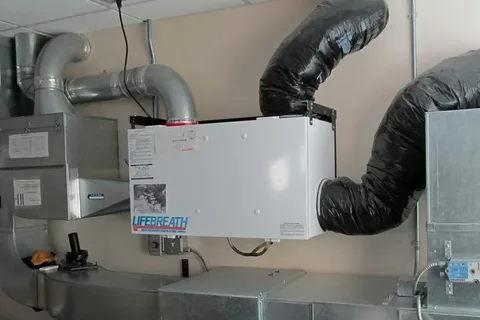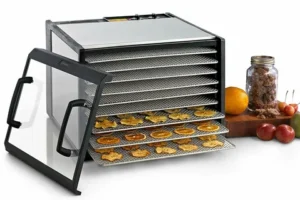In an era where energy efficiency and indoor air quality are paramount, understanding the mechanics of your home’s ventilation system is more important than ever. Enter heat recovery unit (HRVs) — the unsung heroes of modern HVAC technology! These innovative systems keep your living spaces fresh and airy and preserve precious energy by reclaiming heat that would otherwise be lost. Whether you’re a homeowner looking to optimize comfort or a DIY enthusiast eager to dive deep into sustainable solutions, this comprehensive guide will demystify HRVs, revealing how they work, their benefits, and tips on selecting the right unit for your needs.
Introduction to Heat Recovery Ventilation Units (HRV)
In today’s world, where energy efficiency and indoor air quality are top priorities for homeowners, heat recovery ventilation units (HRVs) are an innovative solution. Imagine breathing in fresh, filtered air while conserving energy—a dream now a reality thanks to HRV technology. These systems help maintain a comfortable living environment and reduce heating and cooling costs.
If you’ve ever wondered how to keep your home feeling fresh without sacrificing efficiency, this guide will enlighten you on everything you need to know about HRVs. From their impressive benefits to the technical workings behind them, we’ll break down why these units are becoming increasingly popular. Whether you’re renovating or building from scratch, understanding HRVs could be the key to achieving optimal comfort in your space. Let’s dive into the world of heat recovery ventilation and discover what it can offer!
Benefits of Heat Recovery Ventilation Unit
Heat recovery ventilation unit is becoming increasingly popular in residential and commercial buildings due to their ability to provide efficient and cost-effective ventilation. These units extract stale air from inside a building while bringing in fresh outside air. This process improves indoor air quality and has numerous other benefits.
1. Improved Indoor Air Quality
The primary benefit of an HRV unit is improving indoor air quality. Without proper ventilation, indoor air can become stagnant and filled with pollutants such as dust, pollen, and mould spores. This can lead to respiratory issues and aggravate allergies and asthma symptoms. An HRV unit helps maintain a healthy and clean indoor environment by continuously exchanging stale air with fresh outside air.
2. Energy Efficiency
HRV units are designed to recover heat from outgoing stale air and transfer it to incoming fresh air. This means that during the colder months, the heat from the exhaust air is used to preheat the incoming fresh air before it enters the building. As a result, less energy is required to heat the incoming cold outdoor air, leading to significant energy savings on heating costs.
3. Cost Savings
As mentioned above, HRV units can help reduce heating costs by reducing energy consumption. Additionally, these units also help reduce cooling costs during warmer months as they work in reverse—extracting heat from incoming warm outdoor air and transferring it into outgoing cooler indoor air.
4. Improved Comfort
Buildings can become stuffy or humid without proper ventilation, making occupants feel uncomfortable or unwell. HRV units help regulate humidity levels by removing excess moisture while controlling temperature fluctuations throughout the year – ultimately providing a more comfortable living or working environment.
5. Reduced Condensation & Mold Growth
Excess moisture in a building can lead to condensation on windowsills and walls, creating an ideal environment for mold growth, which can be harmful to health and property. HRV units help reduce moisture levels by continuously exchanging stale, humid air with fresh, drier outside air, effectively preventing condensation and reducing the risk of mold growth.
Heat recovery ventilation units offer a multitude of benefits, including improved indoor air quality, energy efficiency, cost savings, improved comfort, and reduced risks of condensation and mold growth. If you want to invest in a ventilation system for your building, an HRV unit is undoubtedly worth considering.
How HRVs Work
Heat Recovery Ventilation Units (HRVs) operate using a simple yet effective principle. They exchange stale indoor air with fresh outdoor air while transferring heat.
In winter, HRVs draw in cold outside air. Before this air enters your home, it passes through a heat exchanger, where warmth from the outgoing stale air preheats it. This process helps maintain comfortable indoor temperatures without wasting energy.
During the summer months, the system works inversely. The warm indoor air cools down incoming hot external air as it passes through the heat exchanger, providing refreshing ventilation.
The heart of an HRV lies in its balanced airflow system. It ensures that equal amounts of fresh and exhaust air are moved in and out of your space, maintaining pressure balance and promoting healthy indoor climates throughout the year.
Factors to Consider When Choosing a Heat Recovery Ventilation System
Size and capacity are crucial when selecting a heat recovery ventilation system. An adequately sized system ensures effective air exchange without overworking the unit or wasting energy.
Efficiency rating also plays a significant role. Look for high-heat recovery efficient units to maximize energy savings while maintaining comfortable indoor temperatures. Noise level is another consideration. Some models operate quietly, essential if your living space requires peace and tranquillity.
Maintenance requirements shouldn’t be overlooked. Regular filter changes and cleaning intervals can vary between units, impacting long-term performance. Lastly, assess your budget. Costs can vary widely based on features and efficiencies. Investing in a quality HRV may lead to lower utility bills in the long run, but ensure it aligns with your financial plan.
– Size and Capacity
Size and capacity are critical factors when choosing a heat recovery ventilation unit. A unit that’s too small won’t adequately ventilate your space, leading to stale air and moisture buildup. Conversely, an oversized unit can lead to unnecessary energy consumption. To determine the right size, consider your home’s square footage and specific airflow needs. Each room may have different requirements based on usage and occupancy levels.
Additionally, pay attention to the air exchange rate measured in CFM (cubic feet per minute). This value indicates how much air the HRV can move. Matching this rate with your home’s layout ensures optimal performance without wasting energy.
Consulting with a professional can provide insights tailored to your specific environment. They might also factor in local climate conditions for a more precise recommendation. Proper sizing is essential for maximizing efficiency while maintaining comfort throughout your living space.
– Efficiency Rating
When selecting a heat recovery ventilation unit, the efficiency rating is crucial. This number indicates how effectively the unit transfers heat from outgoing air to incoming air. A higher efficiency rating means better performance and lower energy costs.
Typically measured as a percentage, an efficient HRV can recover up to 90% of your home’s thermal energy. This translates into significant savings on heating and cooling bills throughout the year. Look for models that provide an Energy Star certification or similar endorsements. These ratings ensure you’re investing in technology that meets rigorous standards for energy conservation.
Additionally, consider seasonal variations in efficiency. Some units perform differently based on climate conditions, so check their specifications accordingly. An HRV with a high-efficiency rating will enhance indoor comfort and contribute positively to environmental sustainability by reducing overall energy consumption.
– Noise Level
Noise level is a crucial factor when selecting a heat recovery ventilation unit. After all, you want to enjoy fresh air without the annoying hum of machinery in the background.
Different HRV units produce varying sound levels. Some are designed for quiet operation, making them ideal for bedrooms and living spaces. Others may be louder but offer higher performance metrics. When assessing noise levels, look at the decibel ratings provided by manufacturers. A lower rating indicates quieter operation, which can significantly enhance your comfort at home.
Additionally, pay attention to the unit’s design. Features like insulated casings can help dampen sound even further. Choosing an HRV that balances efficiency and noise will make your indoor environment more pleasant and relaxing.
– Maintenance Requirements
Maintaining your HRV unit is crucial for its performance and longevity. Regular maintenance ensures the system runs efficiently, providing optimal air quality in your home.
Start with filters; they should be checked monthly. If they’re clogged with dust and debris, airflow suffers significantly. Clean or replace them as needed to keep things running smoothly. The unit’s core components also require attention. Inspect heat exchangers annually for signs of buildup or damage. A simple cleaning can drastically improve efficiency.
Remember ductwork! Check it regularly for leaks or blockages, which can hinder airflow and reduce overall effectiveness. Lastly, consider scheduling a professional inspection once a year. This step helps catch potential issues early before they escalate into costly repairs. Keeping up with these tasks will help you enjoy fresh air without interruption.
– Cost
When weighing the cost of a heat recovery ventilation unit, consider both upfront and long-term expenses. The initial investment can vary significantly based on your chosen model and features. Basic units may start at a lower price point, while advanced systems with enhanced efficiency or smart technology often come at a premium. Researching different brands will help you find the right fit for your budget.
Don’t overlook installation costs either; hiring professionals ensures proper setup but adds to your overall expenditure.
Think about future savings too. An efficient HRV can reduce energy bills by optimizing heating and cooling needs over time. This balance between immediate costs and long-term gains is essential when deciding. Finally, consider potential rebates or incentives for energy-efficient appliances in your area, which might ease the financial burdens of purchasing an HRV unit.
Installation Process of HRV Units
Installing a Heat Recovery Ventilation (HRV) unit involves several key steps. First, assess the space where the unit will be placed. A suitable location ensures optimal airflow and easy maintenance access. Next, gather all necessary tools and materials. This typically includes ductwork, connectors, screws, and insulation tape. Then, outline your ventilation layout carefully to avoid any airflow issues later.
Once everything is set up, mount the HRV unit according to manufacturer guidelines. Secure it properly to prevent vibrations during operation. Then, connect the intake and exhaust ducts while ensuring they are airtight.
Finally, test your system after installation is complete. Check air pressure and flow rates to make sure it’s functioning correctly. Proper installation guarantees energy efficiency and maximizes performance over time.
Tips for Maintaining and Cleaning Your Heat Recovery and Ventilation System
Maintaining your heat recovery and ventilation system is essential for optimal performance. Regular cleaning ensures efficient airflow and improved air quality. Start with the filters. Check them every month, especially during heavy use periods. Clean or replace them as needed to prevent dust buildup.
Next, inspect the heat exchanger. This component can gather dirt over time, reducing efficiency. Gently wipe it down using a damp cloth and mild cleaner.
Remember the fans! They play a crucial role in circulation. Dust them off carefully; this helps reduce noise levels and enhances functioning.
Also, drainage lines should be checked for blockages to avoid moisture problems. Keeping these clear promotes proper water flow and prevents mould growth. Finally, schedule professional maintenance annually to address any hidden issues and ensure smooth operation throughout the year without unexpected interruptions.
Conclusion
Deciding whether a heat recovery unit is suitable for your home or office involves considering several factors. First, reflect on your current indoor air quality and comfort levels. If you live in an area with extreme temperatures or high humidity, an HRV can significantly enhance your living environment. Evaluate the size of your space. Larger areas may require more powerful units to ensure optimal airflow. Keep in mind that energy efficiency also plays a critical role; higher-rated models can save money in the long run while providing consistent performance.
FAQs
1. What is a heat recovery unit?
A heat recovery unit is a mechanical system that improves indoor air quality by exchanging stale indoor air with fresh outdoor air and recovering heat from the outgoing air to preheat the incoming air. This process improves energy efficiency and reduces heating costs.
2. How does an HRV unit work?
HRV units have two airstreams, one bringing fresh outdoor air and the other exhausting stale indoor air. The two streams pass through a heat exchanger where the outgoing, warm air transfers heat to the incoming cool air without mixing it. The now-preheated fresh air is distributed throughout the house, while the stale indoor air is expelled outside.
3. What are the benefits of using an HRV unit?
Installing an HRV unit in your home or building has several benefits. First, it improves indoor air quality by constantly circulating fresh outdoor air and removing pollutants, allergens, and excess humidity from inside. Second, it helps maintain comfortable temperatures without wasting excess energy as it recovers up to 80% of heat from outgoing exhaust airflow.
| Related Business Listings |
| Contact Directory |
| Local Business Profiles |




